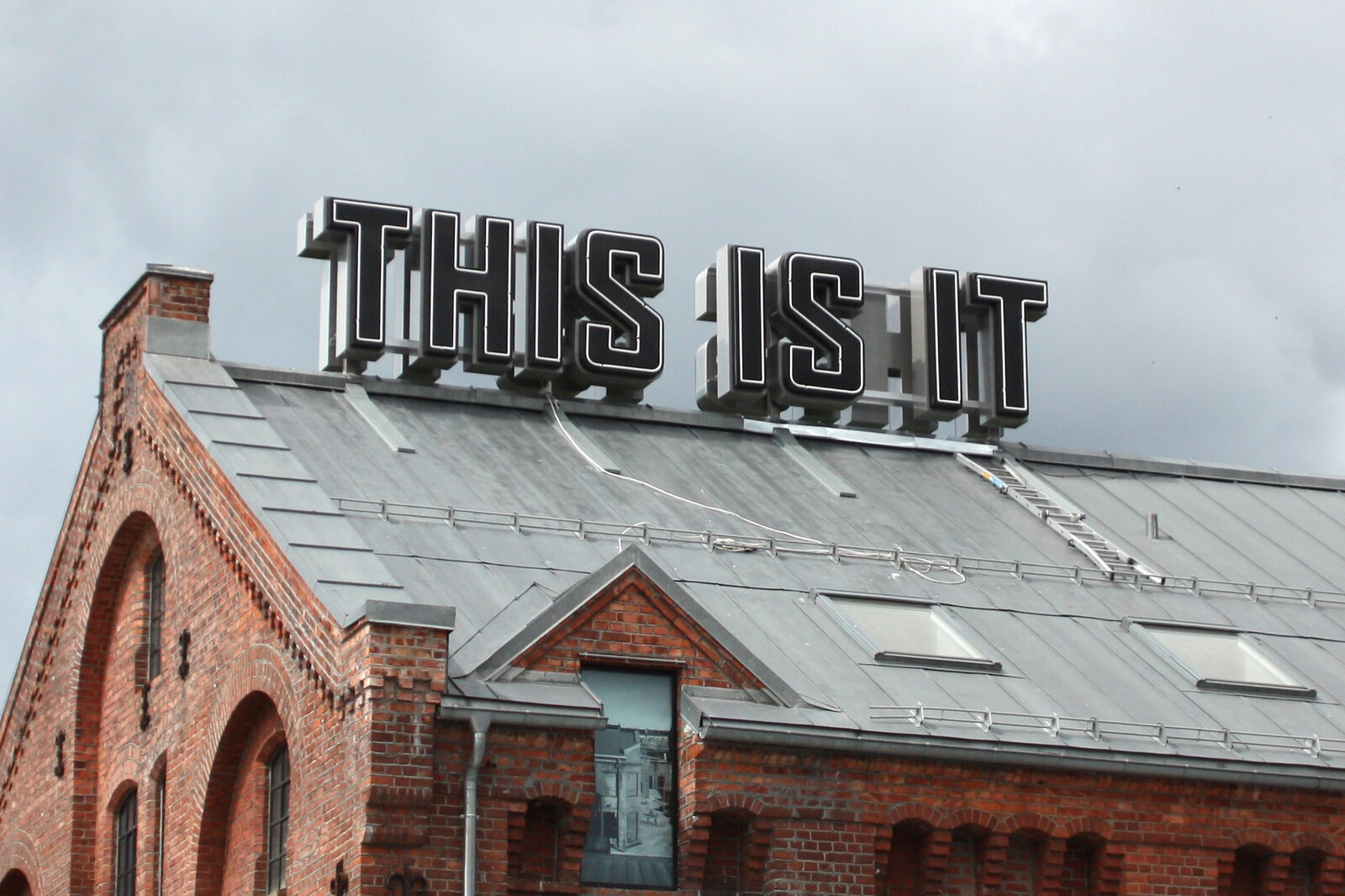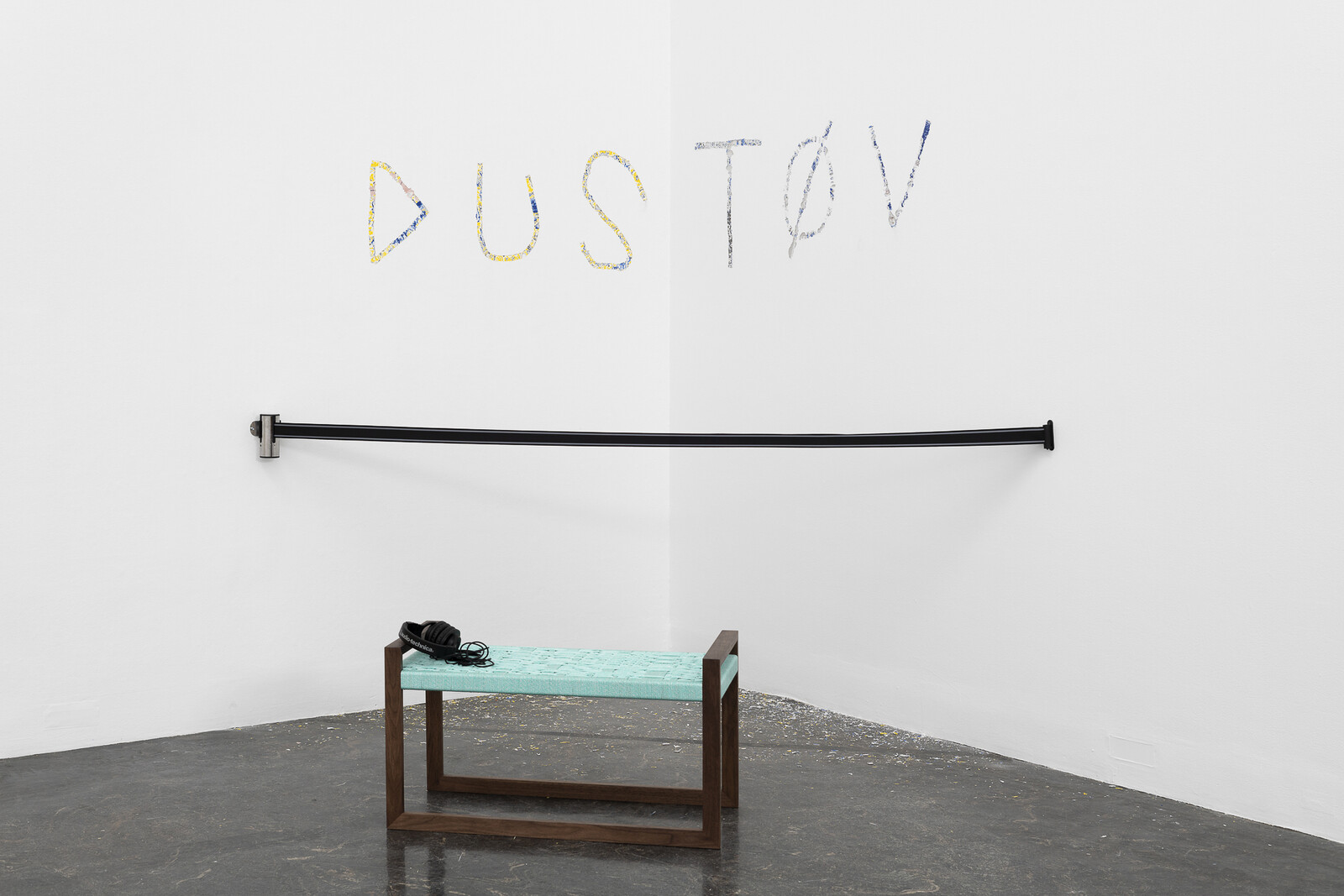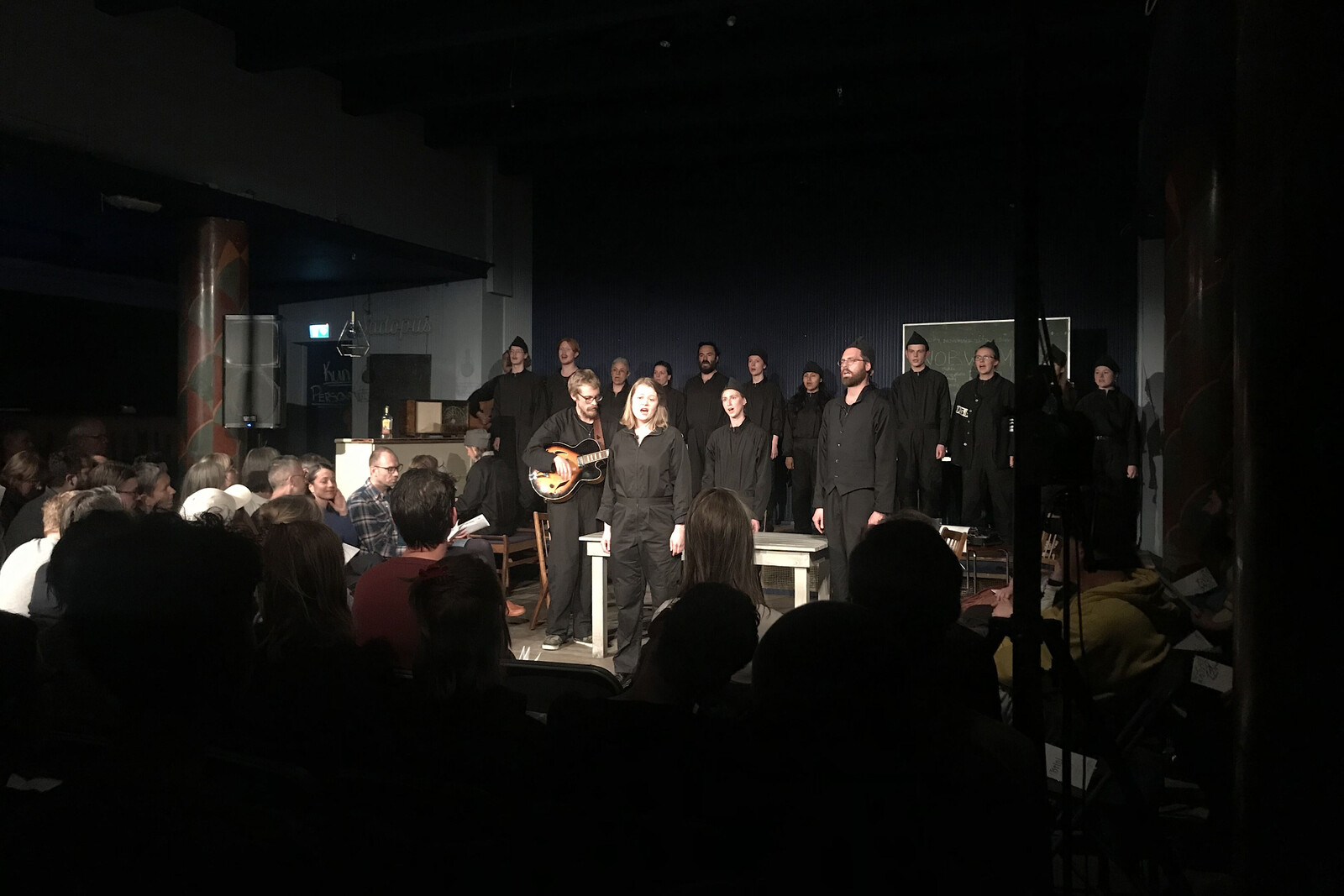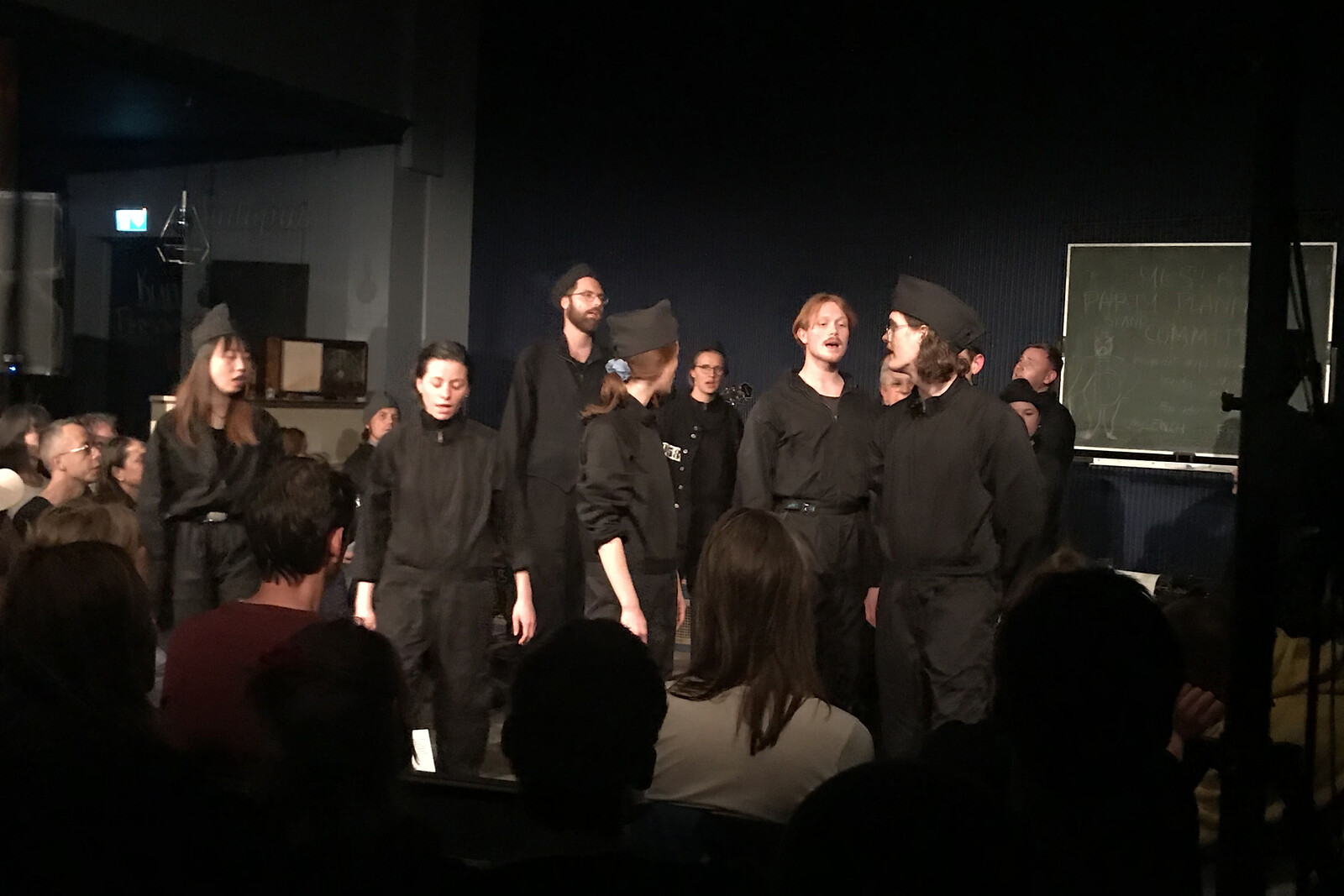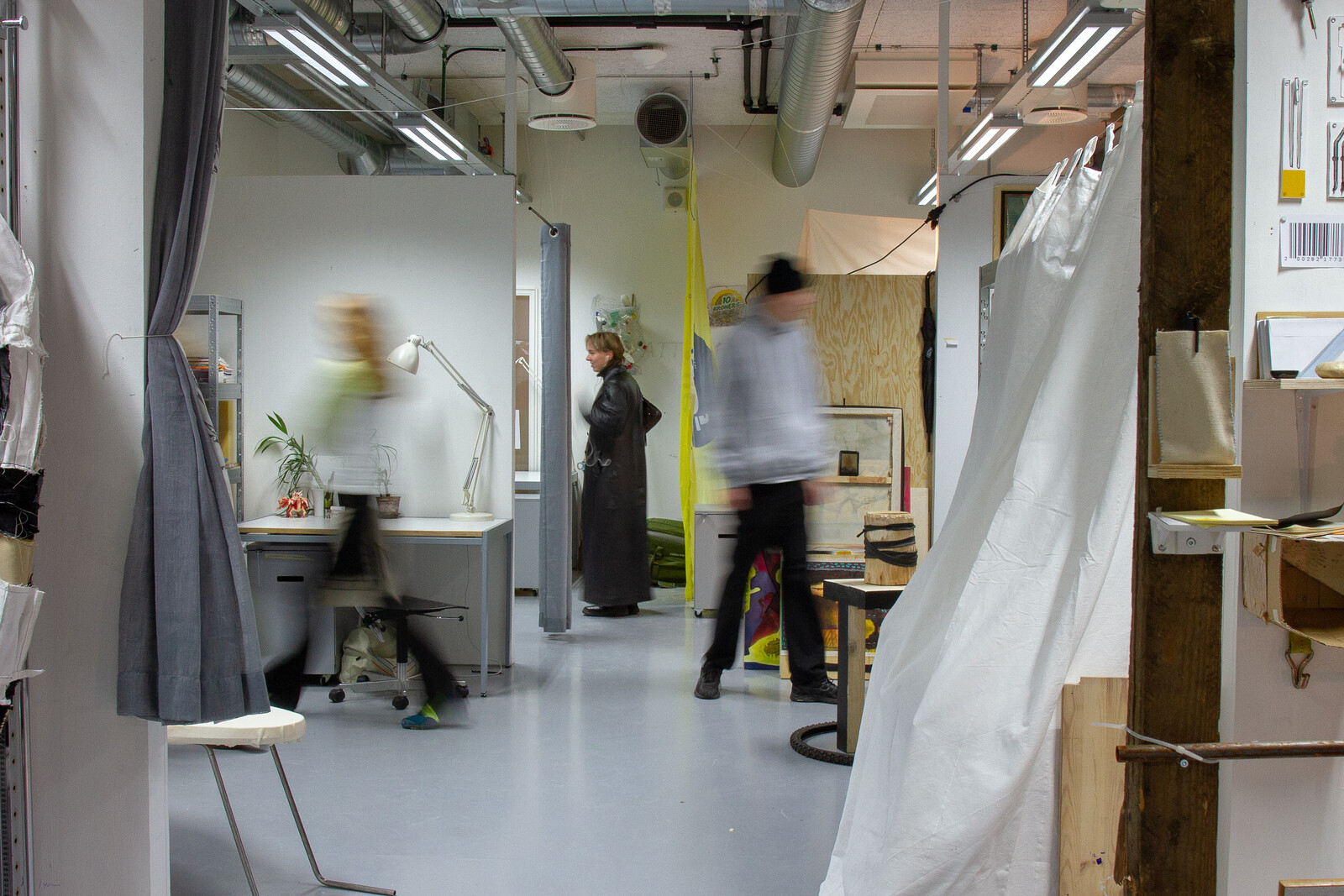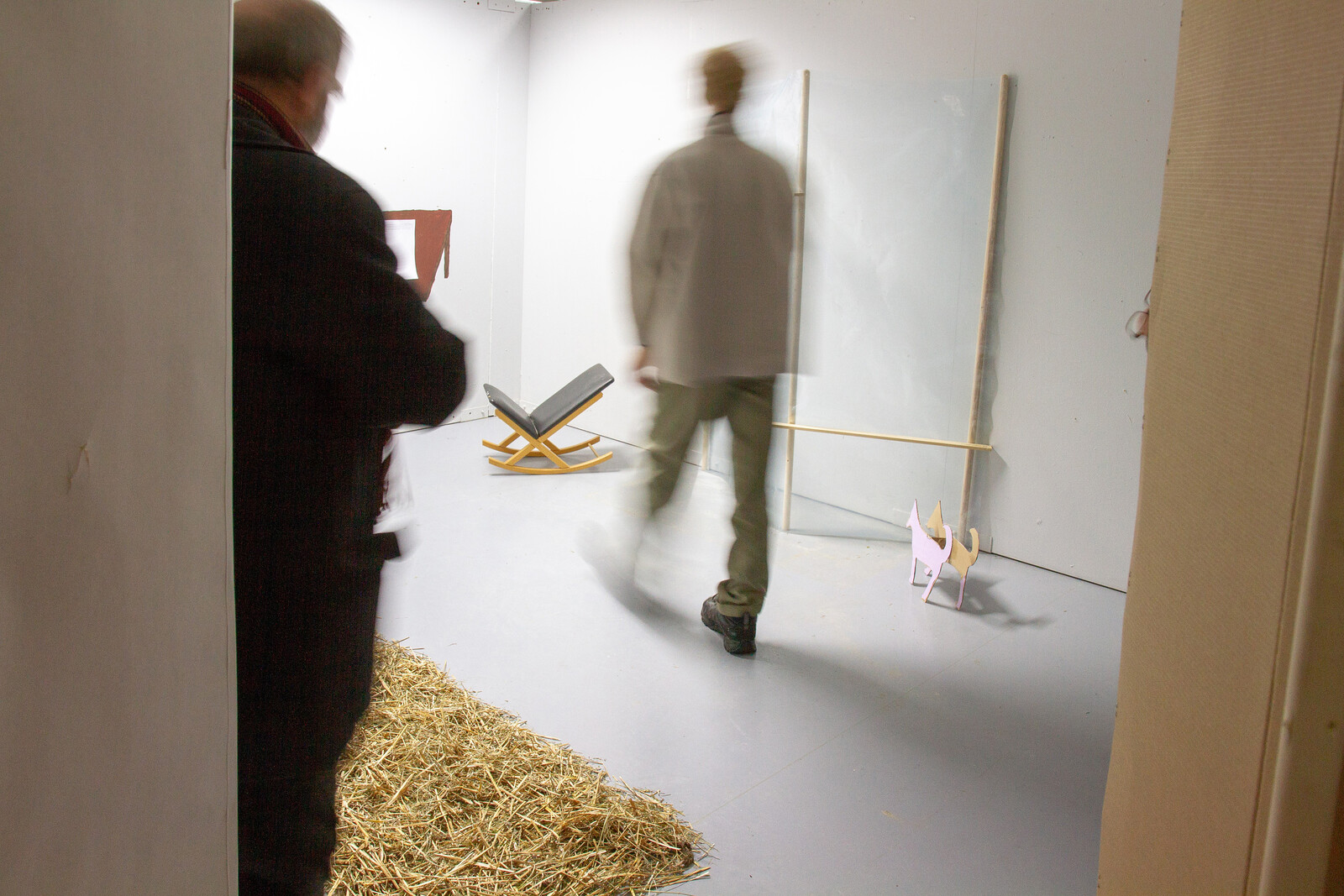In October 1972, Joseph Beuys was dismissed from the Kunstakademie Düsseldorf for making his course in monumental sculpture open to all who wished to attend. The class attracted dozens more students than could be accommodated, and Beuys drew the ire of the Kunstakademie for enacting a philosophy of education that ran counter to the school’s strict admissions policy. Student protests ensued. The following year, Beuys distilled the conflict between the openness art professes and the structure education requires in his work Demokratie ist lustig (Democracy Is Merry), a silkscreened postcard depicting his forced removal by police from the Kunstakademie. The work and event raise the question: can an art program in a formalized educational institution be truly democratic? The mandates of the Academy of Fine Art at the Oslo National Academy of the Arts and the artists that comprise its community share, to an extent, Beuys’s concerns for art, life, and education and the external actuation of pedagogical discourses and practices. Art as a social act, it seems, is vital to the academy’s faculty and students. The dynamics of assembling—being and thinking together—and belief in community are materialized and conceptualized not only in the production of artworks at the Academy of Fine Art but in the projects, workshops, and kinships that develop among students and between students and faculty.
Academy of Fine Art dean Stine Hebert described the school as a “safe yet experimental space, a structure that is highly compelling yet also challenging,” built on “solidarity and freedom.” It offers a “collective realm for students” where agency and experimentation are encouraged. Bachelor’s and master’s students mix in group critique sessions and courses, and independent work—the students’ studio practice—is a key element of the MFA program. Academy of Fine Art (AFA) is not a “professor” school: students do not study under one faculty member during their time but rather change mentors each year. This institutional model, Hebert said, requires “great demands for independence,” and students’ autonomy, enacted toward collective rather than individualist ends, is one of the school’s strengths. The academy encourages MFA students to develop their studio practices and participate in any offered course rather than follow a predetermined progression of courses. (There is, however, a set of requirements students must pass). Students are welcome to invite artists and peers outside the academy for studio visits, reflecting the school’s ethos of flexibility and openness. The academy’s pedagogical intention, Hebert said, is to “show the MFA students their way, and to support them within these open structures, which are devoted to artistic practice and the voice of the students—an international group of young artists from all over the world.”
The academy is part of the Oslo National Academy of the Arts (KHiO), which, in August 2007, opened its new home in a former sail factory in the Grünerløkka neighborhood of East Oslo. At Grünerløkka, KHiO consolidated physically the independent academies of Fine Art, Design, Craft, Stage Arts, and Opera that were formalized in 1996 into a single large organization—a merger that, by degrees, fragmented the independent autonomy of each constituent school. The Academy of Fine Arts, established in 1909, relocated from its small and rather old yet charming building at Sankt Olavs gate near central Oslo to the new campus complex. The former factory makes for a stunning art academy, and offers facilities any artist would dream of: large and modern auditoriums; private studios for fine art students; media labs replete with analogue and digital technologies and 3-D printing; a comprehensive library; and enormous ceramic, metal, wood, textile, weaving, graphics, and publishing workshops. Rarely are such amenities to be found within a single art educational institution, and at AFA artists have the means to produce whatever they want. 1
Thanks to funding from the Norwegian government, the academy offers one of the few truly tuition-free fine art master’s programs in the world. (Sweden recently introduced fees for applicants from outside the European Union. 2) Paired with its instruction in English—in 2015 the BFA reverted to Norwegian, a decision criticized by a large number of the educators—the MFA program is able to enroll students from many and various geographic, cultural, and social backgrounds. 3 “We can bring people in and we can be diverse,” said Maryam Jafri, professor of contemporary art. “We can be broad and fit together a class of diversity in terms of gender, ethnicity, class, and nationality. There is also a diversity in the artistic practices among the master’s students.” Jafri was a member of the 2019 MFA selection committee along with professor of contemporary art Tris Tristam Valentin Vonna-Michell, an MFA student representative, and other administrators. Their discussions placed particular importance on greater transparency, the urgency of fostering a milieu of diversity, and the academy’s investment in the local and national art communities.
The academy’s present-day adherence to the principles of openness and inclusion arises from two connected, simultaneous conditions: AFA being an art educational institution based on certain Scandinavian social values—trust, equal opportunity, and solidarity—and the internationalization of the institution and its faculty in the early 2010s. Vanessa Ohlraun, now rector at Braunschweig University of Art, served as the academy’s dean from 2011 to 2016 and facilitated the hiring of many international artists as professors. (A majority remain on the faculty. Many international students stay in Oslo after graduating.) At that same time, due in part to new types of stipends introduced by the Norwegian Arts Council, Oslo cultivated a rather vibrant art scene through many artist-run initiatives and collaborations. Artists in Norway were provided exceptional opportunities through public support and the freedom to create projects and platforms independent of the art market and established art institutions. Suddenly, it seemed this small Scandinavian city had secured a spot on the international art map and recognition as a hub for contemporary art. The newly internationalized school and the nascent bona fide art scene influenced one another symbiotically, and this coexistence developed further under Hebert, who will leave the academy at the end of this term.
More than two decades on, the creation of the National Academy of Art remains a sensitive topic at AFA. While the school enjoys first-class facilities and resources thanks to the National Academy, the relationship between KHiO and AFA has its imperfections, namely that the larger institution requires adherence to an organizational structure at odds with the sensibilities of the smaller. Many of the students and faculty stressed what they described as a bureaucratization of the school through the implementation of a new public management model that replaced the school’s robust democratic governance. Top-down decision making, new rules, and long and complicated communication methods have exasperated certain distinctions between the faculty and students and have created division among the students themselves. This has interrupted the “intimacy of the school,” one second-year MFA student said; while many of the faculty are dedicated to creating meaningfully supportive environments for learning, others are less “inclusive” and not really “showing up.” Participation varies among students, but involvement in institutional politics is remarkably high at AFA compared with other art schools. The students, heavily invested in postcolonial, post-feminist, and ecological discussions, are “making their voices heard,” said Dora García, professor of contemporary art. One reason for this, she said, arose from the #MeToo movement that “happened at the school when it happened everywhere else, causing a general change of positions.”
Jan Verwoert, professor of contemporary art, noted a “contradiction at place at the academy”: the top-level management and the economic and social structures imposed on the institution. According to him, the academy—what the students and educators mutually create—is highly invested in the school’s social capital: the means and power of being together, relating to each other, and thwarting the rise of metrics of individual success. Questions of the community’s values and the environment in which the academy exists and concerns related to the production of subjectivity and the postcolonial, to name only some, are under constant consideration. AFA is a unique place where “social rituals are being played out on all levels—rituals far, far away from neoliberal values,” he said. The contradiction enters “from above.” Professor of contemporary art Ane Hjort Guttu drew a similar conclusion when I met her at Kunstnernes Hus, where students had begun to install the MFA degree show. “The solidarity between the faculty and the students is solid,” she said. “But the central organ of the school—admin and the top-leaders—are disconnected from contemporary art and education.”
Many of the current MFA students represent an active generation of young artists eager to collaborate and explore how contemporary art can be produced, conceptualized, and exhibited. The focus is not so much on the urge to simply exhibit works of art but to organize shows, projects, and platforms for the benefit of social dialogue and the collective. Two first-year students also emphasized that a “horizontal thinking,” encouraged by some of the educators, has inspired many of their projects. In the last year, the first-year MFA students organized two groups shows: “Why We Can’t Have Nice Things :-/” (2018) and “Close to Cancellation” (2019). Both engaged concerns regarding what an artist brings to a space and what a show is and can be, topics dwelled upon in the first-year workshops “Scenarios (For Going Public),” led by professor of contemporary art Saskia Holmkvist, which took biennials as the year’s theme, and “Exhibition Practice,” led by associate professor of exhibition studies Lisa Rosendahl. 4 While “Why We Can’t Have Nice Things :-/” took place at Galleri Seilduken, a student gallery open to all KHiO departments, “Close to Cancellation” was presented at Akademirommet (The Academy Room), a small space at the back of Kunstnernes Hus where AFA students organize exhibitions and projects independently. Kunstnernes Hus, an artist-run exhibition space for contemporary art in a stunning building that merges neoclassicism and functionalism, has been an official partner institution of the academy since its founding in 1930.
Educators are also able to organize projects, workshops, and exhibitions at Akademirommet. The space most recently hosted “I Saw the Sign,” a performance workshop led by Verwoert that he said was invested in “the signs, the changing wind, and global warming,” a departure from last year’s performance on “Trump, Merkel, male freaks, and hysterical masculinity.” “I Saw the Sign” also presented a playful yet serious interpretation of Alfred Jarry’s Ubu Roi in which artworks, poetry, and stories filled the same plane. The performances, to a degree, complemented his theory workshop “In Touch with Life,” which discussed the philosophies of Martin Heidegger, Simone Weil, Clarice Lispector, and Henri Bergson. (One first-year MFA student described the workshops as furnishing independence and the academy as providing “a sense of freedom for us students, but if you’re not a good swimmer you may drown here.”) Philosophies of being and life and methods for creating exhibitions collectively and conceptually also influenced the MFA students in their making of “Why We Can’t Have Nice Things :-/” and “Close to Cancellation.”
Faculty profoundly inform the political dimension of AFA’s emphasis on collectivity and can propel it beyond the institution. Rose Hammer, a collective persona initiated by Dora García and AFA alumnus Per-Oskar Leu that now consists of twenty artists, many affiliated with AFA and KHiO, exemplifies this dynamic. For the first edition of the Oslo Biennial First Edition (2019–24), Rose Hammer contributed National Episodes: Grini and the Futures of Norway, a political theatre piece produced over months of rigorous script-writing sessions and rehearsals. “The performance and the group,” García said, are invested “in the socialist realism of Brecht” to present how “practice and teaching can be connected in a great way.” The performance itself and the coming together form the work, becoming a medium to enhance the sociality of materials, histories, bodies, and politics. “Art,” as the collective defines it, “is not a mirror held up to reality but a hammer with which to shape it.” 5 Rose Hammer employs the political concretization of social life where neither human bodies nor materials are constructed as one autonomous artwork but as an assemblage of many hammering hands and subjects, continuously forming and memorizing a collective past and a potential future. Rose is, in this sense, not only the alias of socialist heroics or the collective person for an artist group but of all of us, fragmenting, creating, shaping, hitting, and changing the world in the name of a “dialectical, didactic, and collective turn.” 6 Even within a country with as strong a social welfare tradition as Norway’s, where else besides an educational institution committed to action might this form of politics and collectivity be found? The breaking down of forms and the even distribution of agency embedded in the production of the collective and “living” artwork manifest the values at stake in García’s projects and those of the Academy of Fine Art.
This year, the MFA degree exhibition roughly coincided with the opening of the Oslo Biennial. Students know when they enroll that in two years’ time their studies will conclude with a public presentation of their work, and the 2019 graduates mounted a more cohesive show than is typical of thesis exhibitions. Academy of Fine Arts supports artistic practice in all mediums, but Maryam Jafri noted a recent tendency among some master’s and bachelor’s students toward “expanded sculpture,” inadvertently echoing Rosalind Krauss’s canonical October essay “Sculpture in the Expanded Field.” Krauss outlined how American postwar art stretched the idea of sculpture from its pure modern Formalist definition into earthworks, video installations, and so forth, in ways that evoked “the model of evolution.” 7 Jafri described a similar contemporary urge among certain students as a “meeting between craft and the digital, a mix between the animated, the virtual, and the craft, installations that have a virtual or perhaps 3-D presence but can be walked around—an expanded sculpture.”
“PLURAL PLUR,” the 2019 degree exhibition, presented different strategies for “expanding” sculpture and propositions for where this multiform practice might lead. Many of the twenty second-year students contributed physically present yet highly performative sculptures that followed a certain logic of objects through which materiality, bodies, and sensation are exploited. Sound works, installations, and performance especially dominated the large rooms of Kunstnernes Hus’s second floor. 8 Louise Jacobs’s project MY WORLD IS EPIC / GRAVITY LOOKS JUST LIKE YOU (2019) offered a retrospective of sorts of her performances since 2013. The scenarios, music, and themes of her earlier works were re-materialized in new choreographies and lunches held in the exhibition space. Morten Langeland’s Støv høres vakkert ut også på engelsk (2019) presented a recorded poem heard only through headphones in one corner of the space and a sleek wall installation of acoustic foam in the opposite corner that create a tactile work that conceptually spread across the gallery’s architecture. Elise Macmillan’s Feeder (2019) and Klokkelått (2019), two two-channel audio works, set silenced sound pieces, computer-generated voices, electronic tones, strings, and recorded ghosts amid an installation of bells, threads, beeswax, sunflower seeds, and other organic matter that model a psychedelic experience of affect and thought.
If “expanded sculpture” offers a concise description of the students’ work, then neo-materialism and process ontologies provide a common theoretical foundation. These logics entered discussions of contemporary art in the early 2010s; former professor of contemporary art Susanne M. Winterling was highly influential in introducing neo-materialist thought to AFA students. 9 According to Mike Sperlinger, professor of theory and writing, tenets of neo-materialism and process ontologies are even “more sustained” today, embedded as they are in many of the students’ readings, writings, and studio practices. 10 The agency of matter and objects has a notable presence in projects produced at the academy, especially those structured around ecological concerns. The work of the academy’s PhD research fellows offers prime examples: Ane Graff recently presented parts of her research project on nonliving matter, bacteria, and the toxicity of the environment at the Nordic Pavilion at the 58th Venice Biennale for the exhibition “Weather Report: Forecasting Future.” 11 Shortly after the opening in Venice, Liv Bugge defended her doctoral research on touching art and wildness, a project heavily invested in epistemology and the breaking down of modern dualisms of life and nonlife and the human and the wild. Fellow PhD researchers Sara Eliassen, Jan Peter Hammer, and Marie Kølbæk Iverssen have developed, respectively, projects on the media ecologies of screens, propaganda, and collective memories; networks, terror, and digital technologies; and gravity and trauma. The PhD research program at AFA does not require a dissertation in its traditional printed form but rather a project founded in artistic practice as research. 12
The intersection of neo-materialism and contemporary art educed at AFA could be located at Kunstnernes Hus. In the right hall of the exhibition space’s second floor, Eva Rosa Hollup and Ye Gyoung Choi have installed a black-box viewing room for their two-channel video and sound installation Farm (2019). Collaboration is a rarity at degree exhibitions, and Hollup and Choi have produced a film that grapples with the natural and political ecology of salmon farming in northern Norway, a topic of heated public debate. At the rear of the black box, behind the audience, a hanging screen displays surveillance footage of salmon swimming slowly in the dark water. The work is concerned with the economy of the salmon fishing industry specifically and the acceleration of food production generally as nodes in capital and environmental systems. In the context of “PLURAL PLUR,” Hollup and Choi’s work illustrates how MFA students can deal critically with visual art as a mode of thinking about correlations between the local and the global, economic and natural ecologies, and individual and collective art-making.
To this end, AFA stands as an open institution promoting the social function of art, forty years after Beuys’s action at Kunstakademie Düsseldorf and his Demokratie ist lustig. It is an inter-relational body that organizes contemporary art, practice, and politics through a community invested in democracy and in mandates of diversity, solidarity, and freedom. Its workshops and projects offer a form of instruction in how artists can learn to move beyond egoism and individualism and create artworks symbiotically, between bodies and between different forms of matter. The academy supports a political and social consciousness in which artistic practice and research contest environmental crisis, nationalism, racism, and gender inequalities. Questions of subjectivity, knowledge, and existence are profoundly explored. The faculty and the students—what Verwoert defined as the academy—reveal what values can be fostered outside the structures of the market, what an institution committed to community in its different forms can produce, and what can be done to stem the tide of neoliberal reform.
—Sara R. Yazdani
The workshops are shared with the other departments at KHiO, particularly the Art and Craft department.
Sweden formalized this policy July 1, 2011. Applicants from the European Economic Area (EEA) and Switzerland are secured a tuition-free education in Norway. See →.
The argument behind the reversion, as a senior advisor in the AFA administration told me, is language policy and the question of Norwegian as the future language of Norway. The shift from Norwegian to English and the internationalization of the universities and art schools have indeed caused significant ongoing debates on language and heritage. While some fear a dissapperance of Norwegian as a a written and spoken language, others argue that the rejection of internationalization speaks against diversity, that it is exclusionary, and that it creates homogenous environments. As AFA demonstrates, internationalizing reinforces diversity in a sound way.
This year, the “Scenarios” workshop collaborated with the 10th Momentum Biennial in Moss, Norway, contributing a publication and extended exhibition.
See →.
Ibid.
Rosalind Krauss, “Sculpture in the Expanded Field,” October 8 (Spring 1979): 30.
The MFA degree show has taken place at various exhibition spaces in Oslo. Most recently, Stenersenmuseet hosted the exhibition until it closed in 2015.
Winterling is currently professor of contemporary art at Trondheim Academy of Fine Art.
Theory and writing, as Sperlinger said, are important for the program as well as the students, of which a majority develop a writing practice along with their material studio practice. This is formalized in his writings and practical publishing workshops.
The exhibition of the Nordic Pavilion, curated by Leevi Haapala and Piia Oksanen, includes works by Ane Graff, Ingela Ihrman, and nabbteeri.
There is no set form or length of the actual thesis. In January 2018, the Ministry of Education approved a PhD program in artistic research. This meant that the former artistic research program in fine art became the current PhD program. See →.
